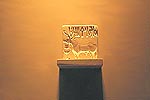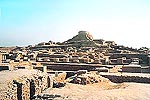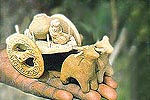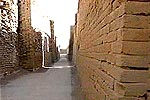Moenjodaro had mud-brick and baked-brick buildings. Covered drainage system in addition to this, soakpits for disposal bins, a large state grannary, a spacious pillared hall, a collage of priests, a large and imposing building (probably a palace) and a citadel mound which incorporates in its margin a system of solid burnt brick tower.
Moenjodaro looks like a planned, organized and master architecture of
urban settlement. Beneath the citadel, parallel streets, some 30 feet
wide, stretched away and  are crossed by other straight
streets, which divide the town into a great oblong block, each 400 yards
in length, and 200 to 300 yards in width. The most imposing remains are
those of a Great Hall which consisted of an open quadrangle with
verandahs on four sides, galleries and rooms on the back, a group of
halls on the north and a large bathing pool. It was probably used for
religious or ceremonial bathing.
are crossed by other straight
streets, which divide the town into a great oblong block, each 400 yards
in length, and 200 to 300 yards in width. The most imposing remains are
those of a Great Hall which consisted of an open quadrangle with
verandahs on four sides, galleries and rooms on the back, a group of
halls on the north and a large bathing pool. It was probably used for
religious or ceremonial bathing.
Nearby are the remains of Great Granary, possibly a public treasury where taxes were paid. We can assume the sensibility of the artistic mind by the discovery of necklaces, pendants of beads, earrings and ankles of ivory and mother of pearl, vessels of silver and bronze and stone weights and measures which suggests the existence of stringent civic regulations.
When the first seal was found in Harappa in 1875 it was thought to be of a foreign origin. A humpless bull with an illegible inscription comprising six characters, were engraved on dark brown jasper.
 The significance of this, and the
multitude of other seals to follow, was felt when it was realized that
the engraved characters and pictures are not only indigenous to the
Indus civilization but a thorough understanding of engravings can give a
comprehensive account of the true nature of the Indus civilization.
First it was thought that the pictograph and the ideograms were related
to Brahmi characters or where perhaps the forerunner of Brahmi. It was
also suggested that the seal was ideophonographic and resembled the
Hieroglyphic seal.
The significance of this, and the
multitude of other seals to follow, was felt when it was realized that
the engraved characters and pictures are not only indigenous to the
Indus civilization but a thorough understanding of engravings can give a
comprehensive account of the true nature of the Indus civilization.
First it was thought that the pictograph and the ideograms were related
to Brahmi characters or where perhaps the forerunner of Brahmi. It was
also suggested that the seal was ideophonographic and resembled the
Hieroglyphic seal.
On the other hand work was being carried on to prove that Dravdian had inherited many Indus signs thus proving the Dravdic affinity of the Indus seal. Its destruction was by the hands of invading Aryan hordes, as some historians believe, or was triggered by an earthquake, or flood the remains of which are yet to be established. The Moenjodaro museum, close to the site of excavation, houses price-less relics found there, including these engraved seals, ornamental utensils, pottery, weapons and toys. Some of the precious things have been recently shifted from the site museum to the local government treasury.
 Interestingly, the bullock carts, boats,
drinking jars, toys used even today in the adjoining areas, bare strong
resemblance to those used by the ancient citizens of Moenjodaro. Through
the discovery of coins and potteries, archeologists believe that trade
and cultural links existed between Moenjodaro and the contemporary
civilizations of Mesopotamia and Egypt.
Interestingly, the bullock carts, boats,
drinking jars, toys used even today in the adjoining areas, bare strong
resemblance to those used by the ancient citizens of Moenjodaro. Through
the discovery of coins and potteries, archeologists believe that trade
and cultural links existed between Moenjodaro and the contemporary
civilizations of Mesopotamia and Egypt.
Various objects d'art found at Moenjodaro include burnt clay male and female figurines, and models of bird, a steatite bust a noble man or a priest-king, wearing a loose robe on which the tretoil pattern is engraved and a small dancing girl of bronze with slim figures and flat negroid features. Steatite seals bearing lifelike representation of animals and mythological creatures such as the unicorn best illustrate the figural. They bear short inscription in a remarkable pictographic script, which has yet to be deciphered.
The various layers of the excavated site show that upon the debris of the
ancient civilization rose the buildings and edifices of a much latter
settlement dating back to the Kushan period (between the first and the
third centuries A.D.).
 The remains of the Buddhist stupa
and the monastery, rising to the height of 10.66 meters (35 feet) above
the surrounding area, are of this later period. How this remarkable
civilization came to an end after 1800 B.C. remains a mystery. Human
skeletons show signs of violent end. Weather this came as a result of
massacre is not certain.
The remains of the Buddhist stupa
and the monastery, rising to the height of 10.66 meters (35 feet) above
the surrounding area, are of this later period. How this remarkable
civilization came to an end after 1800 B.C. remains a mystery. Human
skeletons show signs of violent end. Weather this came as a result of
massacre is not certain.
According to Father Heras the vertical fish sign meant a star, because in most of the Dravidian languages both the star and the fish are referred to as mint. There are many other examples of a similar nature quoted in his works. All this inspired many scholars including, Soviet, Scandinavian and Pakistanis, to start looking into the matter more seriously. Moenjodaro promises tourists, a journey spread over thousand years in one single excursion!


